Home / Reductive Amination
Amines
Reductive Amination
Last updated: April 16th, 2024 |
Making Substituted Amines Through Reductive Amination
- Direct alkylation of amines with alkyl halides is a difficult reaction to control.
- One alternative that works extremely well is to form the imine of an amine with an appropriate aldehyde or ketone, and then to reduce the imine to an amine. This is called reductive amination and avoids the problem of multiple alkylations.
- One common reducing agent for this purposes is sodium cyanoborohydride (NaBH3CN) which can selectively reduce imines in the presence of aldehydes. Many other reducing agents (NaBH4, NaBH(OAc)3, etc.) can be used as well.
- It’s possible to start with a primary amine and do two successive reductive aminations, obtaining a tertiary amine.
- Reductive amination does not work for forming bonds from nitrogen to aromatic rings.
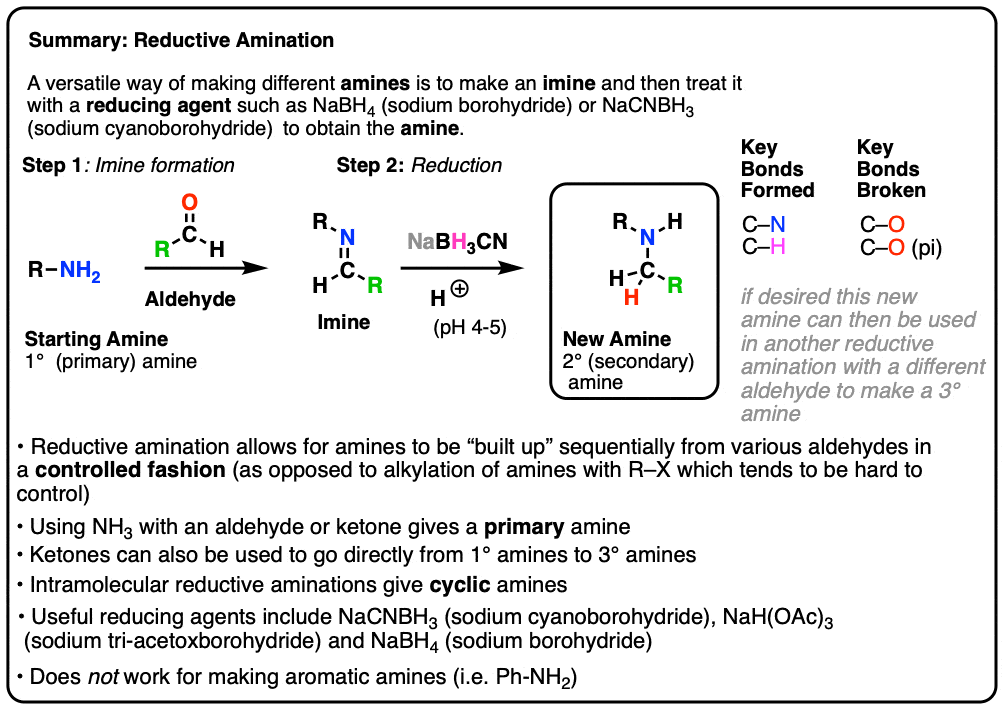
Table of Contents
- How Do We Make This Amine?
- Reductive Amination To The Rescue
- Applying Reductive Amination
- Ketones Also Work
- Sequential Reductive Aminations
- Intramolecular Reductive Aminations
- Working Backwards: Planning A Reductive Amination
- Notes
- Test Yourself!
- (Advanced) References and Further Reading
1. How Do We Make This Amine, If Direct Alkylation Doesn’t Work?
Say you have a primary amine such as benzylamine and would like to make N-methylbenzylamine. How do you do it?
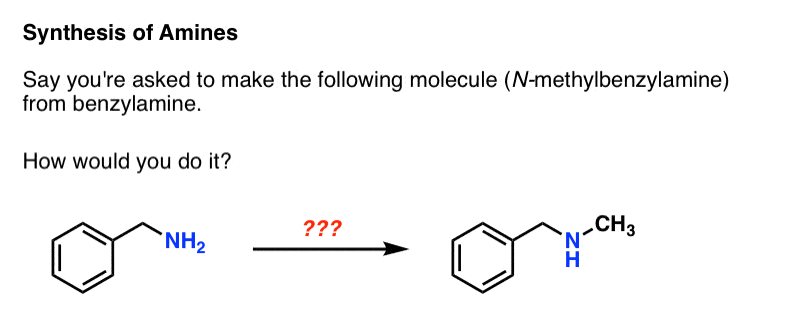
Direct treatment of benzylamine with an alkylating agent (e.g. methyl iodide, CH3I ) will result in significant formation of the undesired tertiary amine (i.e. di-alkylation).
Yes, you could try and separate out the secondary amine that’s formed from the tertiary amine, but we’re not going to settle for 10-30% yields here. Separating mixtures is fine on paper, but (trust me on this) it can be a real a pain in practice. Is there another way to do it?

2. Reductive Amination To The Rescue
Enter reductive amination!
While alkylation can happen multiple times on an amine, imines only form once on a given amine. Once the imine is formed, the C=N bond can be reduced, giving us a new alkyl group attached to nitrogen.
This is a much more controlled manner of forming nitrogen-carbon bonds.
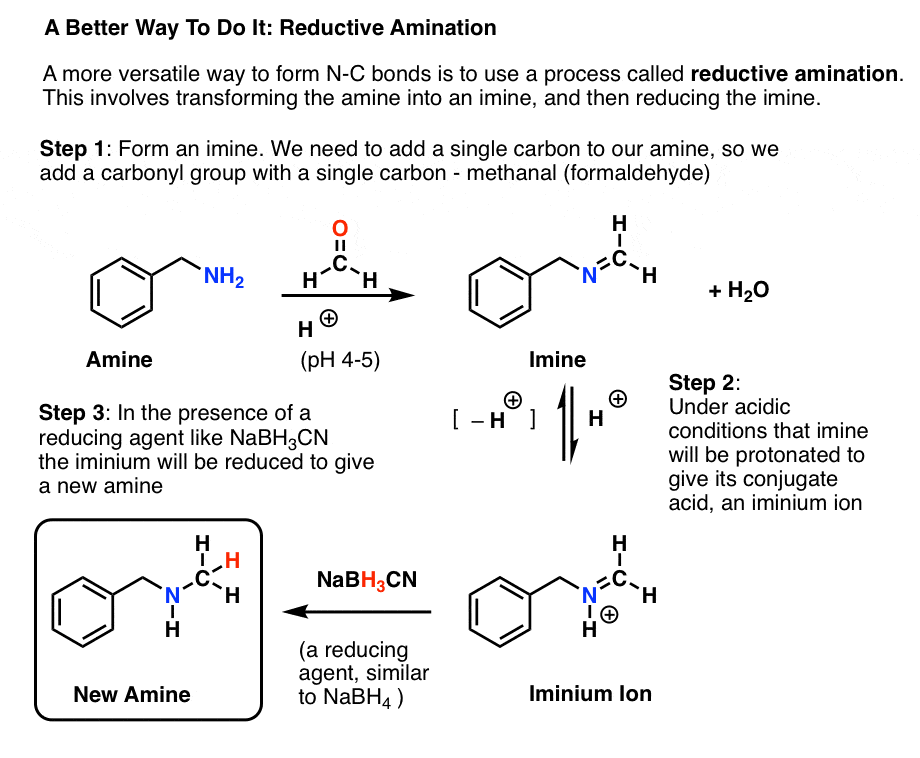
We covered imine formation previously (See article: Imines – Properties, Reactions, Mechanisms). To refresh yourself on the mechanism, hover here and an image will pop up (link).
After the imine is formed, it must be reduced to the amine. It’s possible to use the familiar reducing agent sodium borohydride (NaBH4) for this process. You may recall that NaBH4 is used for the reduction of aldehydes and ketones.
There are two other commonly used reductants for reductive amination: sodium cyanoborohydride (NaBH3CN) and sodium tri-acetoxyborohydride (NaBH(OAc)3 ). For our purposes, they can be considered to be the same. In practice, NaBH3CN is a little bit better than NaBH4.
[For a discussion as to why NaBH3CN tends to be a better choice than NaBH4, see Note 2. In the schemes below, we’ll use NaBH3CN, but NaBH4 and NaBH(OAc)3 can be considered to work just as well. ]
3. Applying Reductive Amination
Reductive amination is extremely versatile and can be used to install a large variety of different alkyl groups on an amine. The nice part is that the groups just go on once.
The table below shows examples of how methyl, ethyl, propyl, butyl, and benzyl groups can be installed on an amine, by employing an appropriate aldehyde . (Note that reductive amination doesn’t work for installing a phenyl group. Why not? Note 1.]

4. Ketones Also Work
What about ketones? They work too! Employing a ketone will result in a branched alkyl substituent on the amine. For example, using acetone in the following reductive amination gives an isopropyl group.
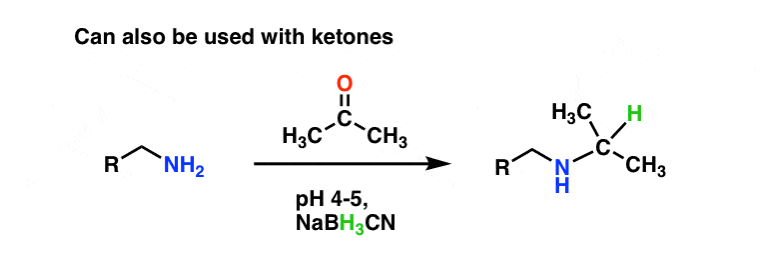
5. Sequential Reductive Aminations
Another useful feature of reductive amination reactions is that two (or three if one starts with ammonia) reductive aminations can be employed in sequence. For example, look at the synthesis of the tertiary amine below.

Importantly, the sequence of reactions isn’t crucial here. We could have done the first reductive amination with benzaldehyde first, and acetone second, and still obtained the same product.
6. Intramolecular Reductive Aminations
Finally, there’s the intramolecular case, which always seems to give students a headache. If a molecule contains both an amine and a carbonyl, then it can cyclize to give a cyclic amine.
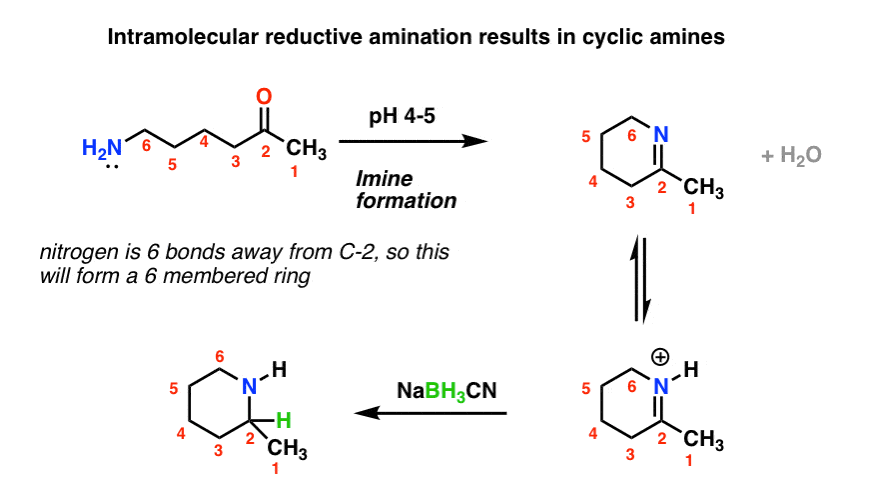
When drawing out the product of ring formation, I strongly advise counting and numbering your carbons. I’ve seen so many students make mistakes when redrawing that it’s well worth the time to double check that you haven’t left anything out.
7. Working Backwards: Planning A Reductive Amination
It might take some time to appreciate, but reductive amination is an extremely powerful way of making amines.
It’s very helpful to be able to think backwards from an amine product to what the starting materials look like.
Look at the following tertiary amine. It is connected to three carbons, which we can label a, b, and c. Each of these N–C bonds could potentially be formed through reductive amination, since they have C-H bonds.
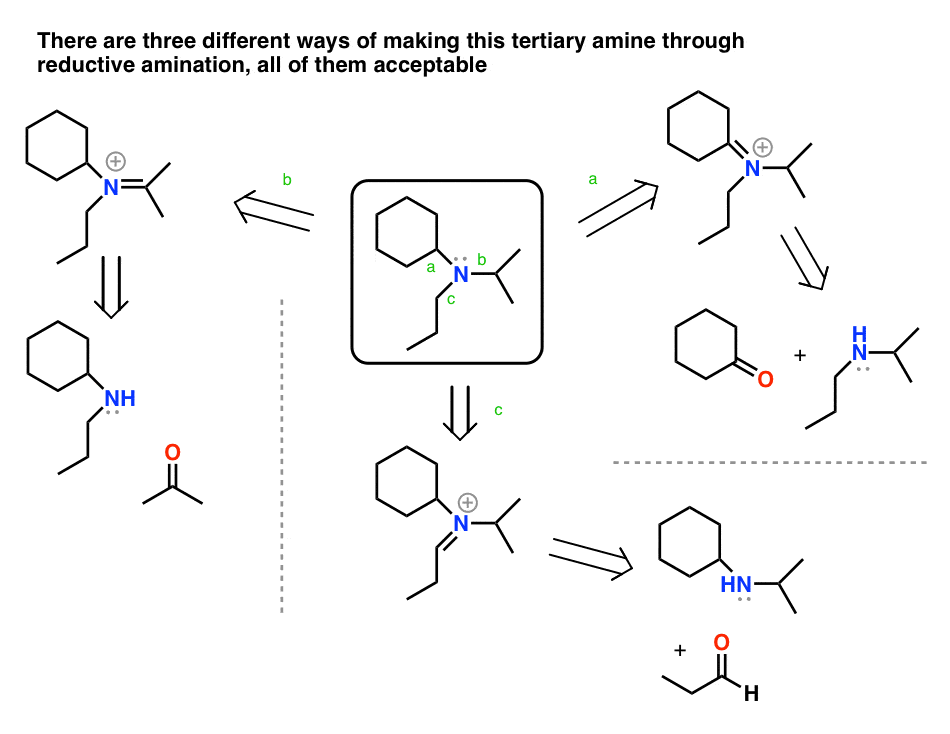
That means that there are three possible ways of making this amine through reductive amination, all of them acceptable!
In short, reductive amination is a very powerful and useful protocol for the formation of amines.
Notes
Related Articles
Note 1. What about installing a phenyl group (see above)? For formation of bonds between nitrogen and sp2-hybridized carbons (e.g. alkenes or phenyl groups) or between nitrogen and sp-hybridized carbons (e.g. alkynes), reductive amination won’t work.
Think about it. Note that the carbon attached to the nitrogen doesn’t have a C-H bond. Therefore we can’t work backwards to the reduction of a C=N bond with a hydride source.

One must resort to alternative techniques. Buchwald-Hartwig cross coupling is one of them.
Note 2. Why sodium cyanoborohydride?
NaBH4 can be a perfectly acceptable reducing agent for reductive amination.
There’s one slight problem with this reagent, however. What if the NaBH4 ends up reducing the aldehyde or ketone before it has a chance to react with the imine? That would lead to lower yields. [In practice, this can be reduced somewhat by giving the imine sufficient time to form, and then adding in NaBH4.]
An even better approach involves the use of the slightly weaker reducing agent sodium cyanoborohydride (NaBH3CN).
Why use a weaker reducing agent?
Recall that formation of an imine is best done under mildly acidic conditions (pH 4 or 5). [At mildly acidic pH, the carbonyl oxygen is protonated, speeding up the rate of addition to the carbonyl carbon; if the solution is too acidic, however, the amine nucleophile will be converted into its (non-nucleophilic) conjugate acid, an ammonium salt, and no reaction will occur.]
Once the imine forms at pH 4-5, some of it will be converted into its conjugate acid, an iminium salt.

The advantage of using NaBH3CN is that it isn’t a strong enough reducing agent to reduce aldehydes or ketones, but it is a strong enough nucleophile to reduce iminium ions. Therefore more of the starting aldehyde/ketone will be converted into the amine. [This is particularly important when working with very precious samples of aldehyde].
Test Yourself!
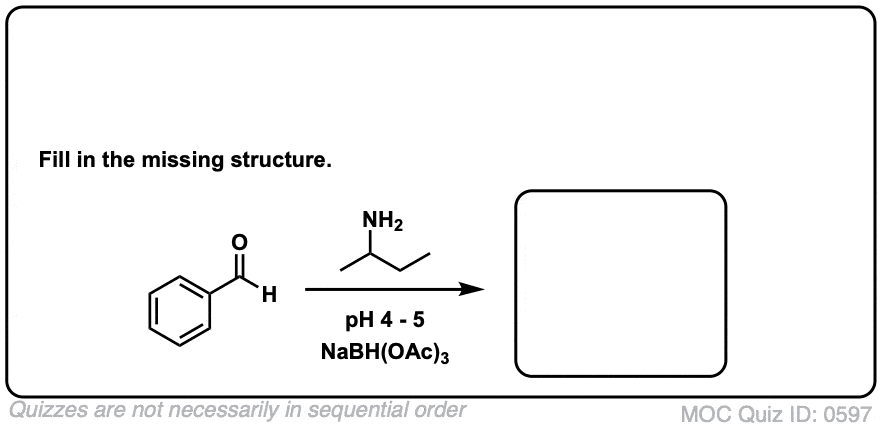 Click to Flip
Click to Flip
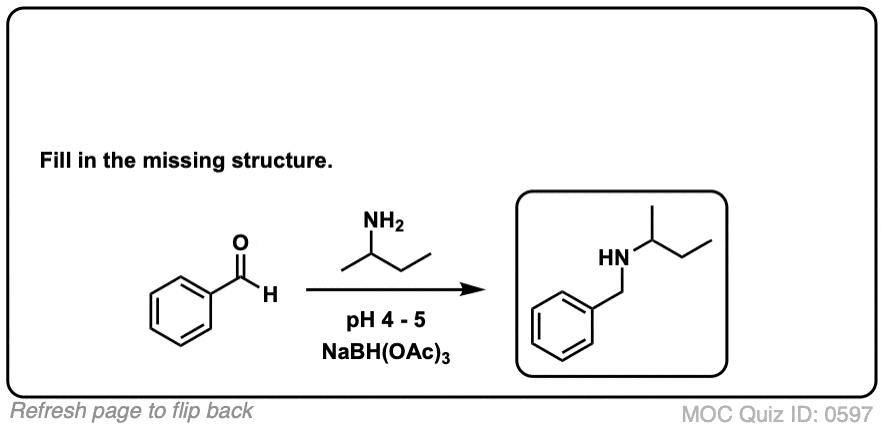
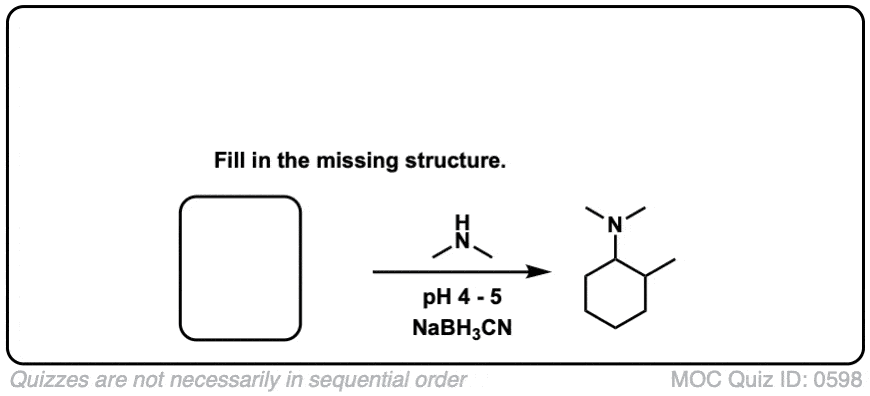 Click to Flip
Click to Flip

 Click to Flip
Click to Flip
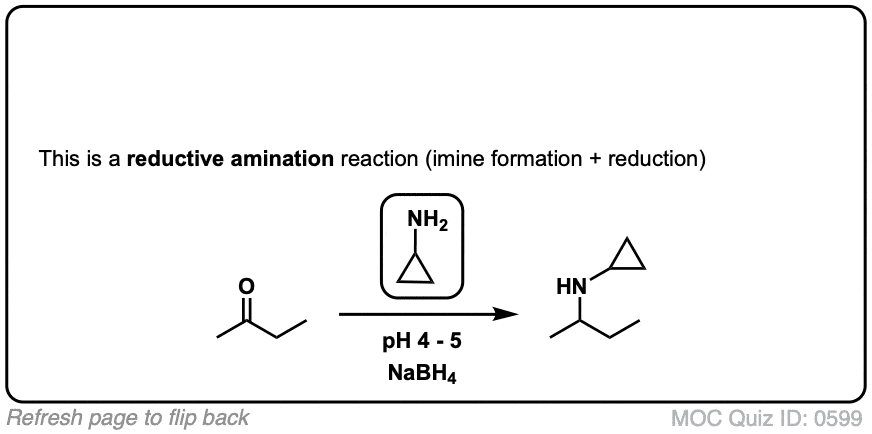
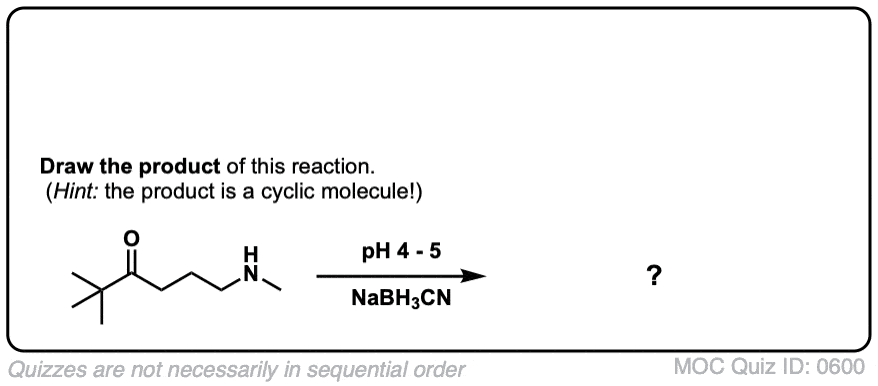 Click to Flip
Click to Flip
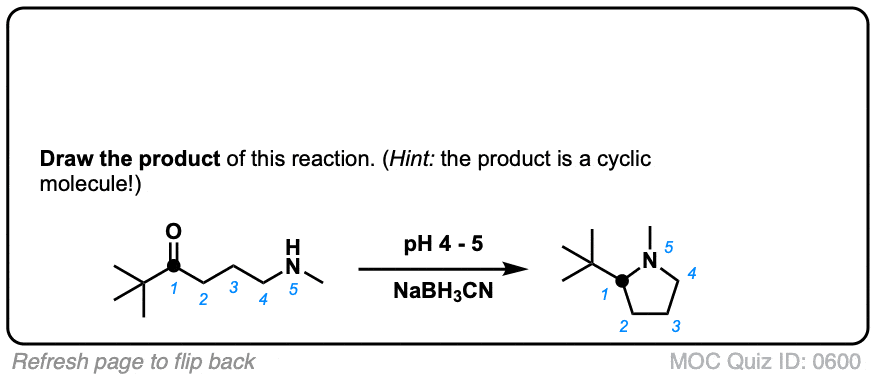
 Click to Flip
Click to Flip

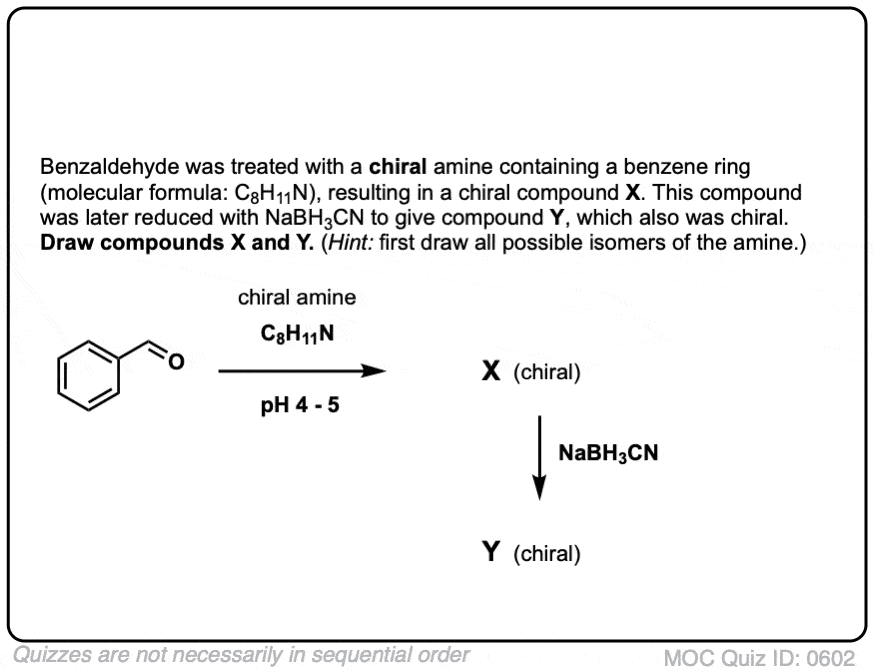 Click to Flip
Click to Flip
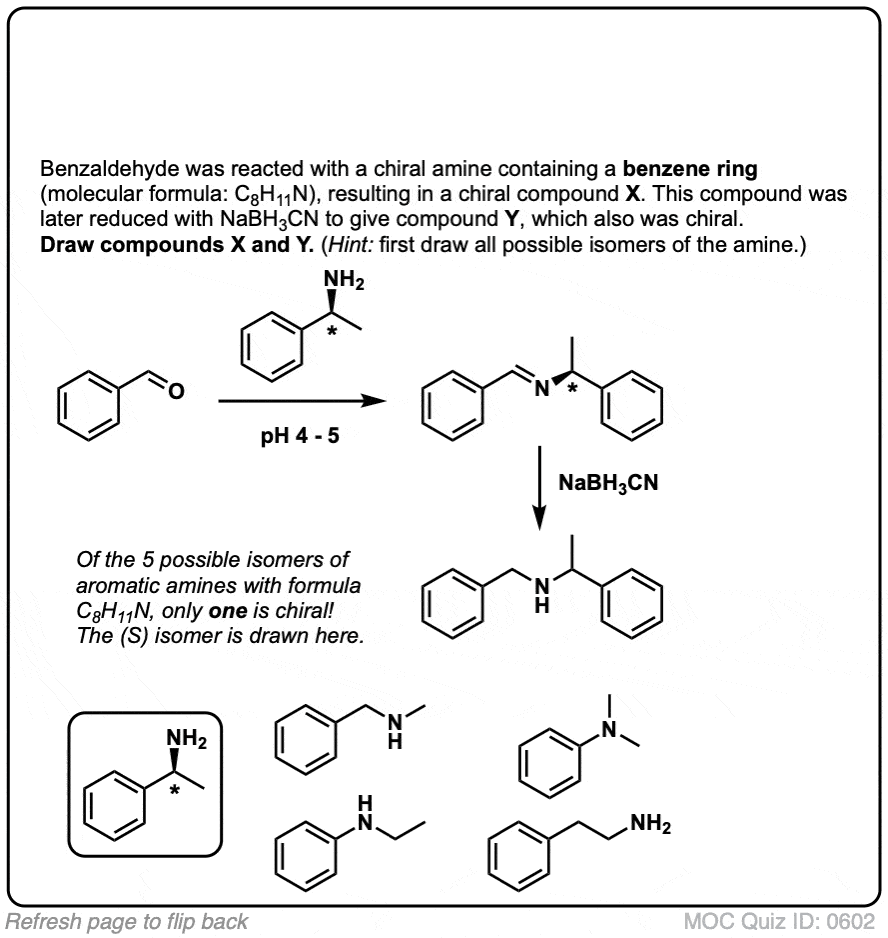
(Advanced) References and Further Reading
- Cyanohydridoborate anion as a selective reducing agent
Richard F. Borch, Mark D. Bernstein, and H. Dupont Durst
Journal of the American Chemical Society 1971, 93 (12), 2897-2904
DOI: 1021/ja00741a013
The first report on the use of NaBH3CN as a reducing agent for reductive amination. - An improved method for reductive alkylation of amines using titanium(IV) isopropoxide and sodium cyanoborohydride
Ronald J. Mattson, Kahnie M. Pham, David J. Leuck, and Kenneth A. Cowen
The Journal of Organic Chemistry 1990, 55 (8), 2552-2554
DOI:1021/jo00295a060
Ti(OiPr)4 can be used as a Lewis acid to activate the ketone/aldehyde towards addition by the amine and the resulting imine can then be reduced in situ by NaBH3CN, which is a reductive amination. - Reductive Amination of Aldehydes and Ketones with Sodium Triacetoxyborohydride. Studies on Direct and Indirect Reductive Amination Procedures
Ahmed F. Abdel-Magid, Kenneth G. Carson, Bruce D. Harris, Cynthia A. Maryanoff, and Rekha D. Shah
The Journal of Organic Chemistry 1996, 61 (11), 3849-3862
DOI: 1021/jo960057x
NaBH(OAc)3 can also be used as a reducing agent in reductive amination procedures as an alternative to NaBH3CN, if one is concerned about cyanide ion concentrations in the product or waste stream. - Development of a Scaleable Route for the Production of cis-N-Benzyl-3-methylamino-4-methylpiperidine
David H. Brown Ripin, Stefan Abele, Weiling Cai, Todd Blumenkopf, Jeffrey M. Casavant, Jonathan L. Doty, Mark Flanagan, Christian Koecher, Klaus W. Laue, Keith McCarthy, Cliff Meltz, Mike Munchhoff, Kees Pouwer, Bharat Shah, Jianmin Sun, John Teixeira, Ton Vries, David A. Whipple, and Glenn Wilcox
Organic Process Research & Development 2003, 7 (1), 115-120
DOI:1021/op025599x
OPRD is a great source of reliable procedures, since reactions being scaled up need to be robust, high-yielding, not require exotic solvents or superstoichiometric amounts of overly expensive reagents, and have simple purification procedures (avoiding chromatography where possible). - One-Pot Reductive Amination of Conjugated Aldehydes and Ketones with Silica Gel and Zinc Borohydride
Brindaban C. Ranu, Adinath Majee, and Arunkanti Sarkar
The Journal of Organic Chemistry 1998, 63 (2), 370-373
DOI: 1021/jo971117h
Zn(BH4)2 can also be used as a reducing agent in reductive amination. - Single Stereodifferentiation Associated with Carbon Atom Insertion during the Oxonium Ion-Initiated Pinacol Rearrangement of Dihydrofuranyl and Dihydropyranyl Carbinols
Leo A. Paquette, James C. Lanter, and Jeffrey N. Johnston
The Journal of Organic Chemistry 1997 62 (6), 1702-1712
DOI: 1021/jo962019j
Prof. Leo Paquette demonstrates that stereodifferentiation is possible in pinacol-type rearrangements. - α-PHENYLETHYLAMINE
John C. Robinson, Jr. and H. R. Snyder
Synth. 1943, 23, 68
DOI: 10.15227/orgsyn.023.0068
A reductive amination using NH3 as the amine. - The 25th Anniversary of the Buchwald–Hartwig Amination: Development, Applications, and Outlook
Paola A. Forero-Cortés and Alexander M. Haydl
Organic Process Research & Development 2019, 23 (8), 1478-1483
DOI: 10.1021/acs.oprd.9b00161
A short review on the Buchwald-Hartwig amination, covering its development, applications, and future prospects. OPRD (along with Organic Syntheses) is a great place to look for reliable and robust reactions, as that is what is most valued in process chemistry, when developing reactions on a large scale.
00 General Chemistry Review
01 Bonding, Structure, and Resonance
- How Do We Know Methane (CH4) Is Tetrahedral?
- Hybrid Orbitals and Hybridization
- How To Determine Hybridization: A Shortcut
- Orbital Hybridization And Bond Strengths
- Sigma bonds come in six varieties: Pi bonds come in one
- A Key Skill: How to Calculate Formal Charge
- The Four Intermolecular Forces and How They Affect Boiling Points
- 3 Trends That Affect Boiling Points
- How To Use Electronegativity To Determine Electron Density (and why NOT to trust formal charge)
- Introduction to Resonance
- How To Use Curved Arrows To Interchange Resonance Forms
- Evaluating Resonance Forms (1) - The Rule of Least Charges
- How To Find The Best Resonance Structure By Applying Electronegativity
- Evaluating Resonance Structures With Negative Charges
- Evaluating Resonance Structures With Positive Charge
- Exploring Resonance: Pi-Donation
- Exploring Resonance: Pi-acceptors
- In Summary: Evaluating Resonance Structures
- Drawing Resonance Structures: 3 Common Mistakes To Avoid
- How to apply electronegativity and resonance to understand reactivity
- Bond Hybridization Practice
- Structure and Bonding Practice Quizzes
- Resonance Structures Practice
02 Acid Base Reactions
- Introduction to Acid-Base Reactions
- Acid Base Reactions In Organic Chemistry
- The Stronger The Acid, The Weaker The Conjugate Base
- Walkthrough of Acid-Base Reactions (3) - Acidity Trends
- Five Key Factors That Influence Acidity
- Acid-Base Reactions: Introducing Ka and pKa
- How to Use a pKa Table
- The pKa Table Is Your Friend
- A Handy Rule of Thumb for Acid-Base Reactions
- Acid Base Reactions Are Fast
- pKa Values Span 60 Orders Of Magnitude
- How Protonation and Deprotonation Affect Reactivity
- Acid Base Practice Problems
03 Alkanes and Nomenclature
- Meet the (Most Important) Functional Groups
- Condensed Formulas: Deciphering What the Brackets Mean
- Hidden Hydrogens, Hidden Lone Pairs, Hidden Counterions
- Don't Be Futyl, Learn The Butyls
- Primary, Secondary, Tertiary, Quaternary In Organic Chemistry
- Branching, and Its Affect On Melting and Boiling Points
- The Many, Many Ways of Drawing Butane
- Wedge And Dash Convention For Tetrahedral Carbon
- Common Mistakes in Organic Chemistry: Pentavalent Carbon
- Table of Functional Group Priorities for Nomenclature
- Summary Sheet - Alkane Nomenclature
- Organic Chemistry IUPAC Nomenclature Demystified With A Simple Puzzle Piece Approach
- Boiling Point Quizzes
- Organic Chemistry Nomenclature Quizzes
04 Conformations and Cycloalkanes
- Staggered vs Eclipsed Conformations of Ethane
- Conformational Isomers of Propane
- Newman Projection of Butane (and Gauche Conformation)
- Introduction to Cycloalkanes (1)
- Geometric Isomers In Small Rings: Cis And Trans Cycloalkanes
- Calculation of Ring Strain In Cycloalkanes
- Cycloalkanes - Ring Strain In Cyclopropane And Cyclobutane
- Cyclohexane Conformations
- Cyclohexane Chair Conformation: An Aerial Tour
- How To Draw The Cyclohexane Chair Conformation
- The Cyclohexane Chair Flip
- The Cyclohexane Chair Flip - Energy Diagram
- Substituted Cyclohexanes - Axial vs Equatorial
- Ranking The Bulkiness Of Substituents On Cyclohexanes: "A-Values"
- Cyclohexane Chair Conformation Stability: Which One Is Lower Energy?
- Fused Rings - Cis-Decalin and Trans-Decalin
- Naming Bicyclic Compounds - Fused, Bridged, and Spiro
- Bredt's Rule (And Summary of Cycloalkanes)
- Newman Projection Practice
- Cycloalkanes Practice Problems
05 A Primer On Organic Reactions
- The Most Important Question To Ask When Learning a New Reaction
- Learning New Reactions: How Do The Electrons Move?
- The Third Most Important Question to Ask When Learning A New Reaction
- 7 Factors that stabilize negative charge in organic chemistry
- 7 Factors That Stabilize Positive Charge in Organic Chemistry
- Nucleophiles and Electrophiles
- Curved Arrows (for reactions)
- Curved Arrows (2): Initial Tails and Final Heads
- Nucleophilicity vs. Basicity
- The Three Classes of Nucleophiles
- What Makes A Good Nucleophile?
- What makes a good leaving group?
- 3 Factors That Stabilize Carbocations
- Equilibrium and Energy Relationships
- What's a Transition State?
- Hammond's Postulate
- Learning Organic Chemistry Reactions: A Checklist (PDF)
- Introduction to Free Radical Substitution Reactions
- Introduction to Oxidative Cleavage Reactions
06 Free Radical Reactions
- Bond Dissociation Energies = Homolytic Cleavage
- Free Radical Reactions
- 3 Factors That Stabilize Free Radicals
- What Factors Destabilize Free Radicals?
- Bond Strengths And Radical Stability
- Free Radical Initiation: Why Is "Light" Or "Heat" Required?
- Initiation, Propagation, Termination
- Monochlorination Products Of Propane, Pentane, And Other Alkanes
- Selectivity In Free Radical Reactions
- Selectivity in Free Radical Reactions: Bromination vs. Chlorination
- Halogenation At Tiffany's
- Allylic Bromination
- Bonus Topic: Allylic Rearrangements
- In Summary: Free Radicals
- Synthesis (2) - Reactions of Alkanes
- Free Radicals Practice Quizzes
07 Stereochemistry and Chirality
- Types of Isomers: Constitutional Isomers, Stereoisomers, Enantiomers, and Diastereomers
- How To Draw The Enantiomer Of A Chiral Molecule
- How To Draw A Bond Rotation
- Introduction to Assigning (R) and (S): The Cahn-Ingold-Prelog Rules
- Assigning Cahn-Ingold-Prelog (CIP) Priorities (2) - The Method of Dots
- Enantiomers vs Diastereomers vs The Same? Two Methods For Solving Problems
- Assigning R/S To Newman Projections (And Converting Newman To Line Diagrams)
- How To Determine R and S Configurations On A Fischer Projection
- The Meso Trap
- Optical Rotation, Optical Activity, and Specific Rotation
- Optical Purity and Enantiomeric Excess
- What's a Racemic Mixture?
- Chiral Allenes And Chiral Axes
- Stereochemistry Practice Problems and Quizzes
08 Substitution Reactions
- Introduction to Nucleophilic Substitution Reactions
- Walkthrough of Substitution Reactions (1) - Introduction
- Two Types of Nucleophilic Substitution Reactions
- The SN2 Mechanism
- Why the SN2 Reaction Is Powerful
- The SN1 Mechanism
- The Conjugate Acid Is A Better Leaving Group
- Comparing the SN1 and SN2 Reactions
- Polar Protic? Polar Aprotic? Nonpolar? All About Solvents
- Steric Hindrance is Like a Fat Goalie
- Common Blind Spot: Intramolecular Reactions
- The Conjugate Base is Always a Stronger Nucleophile
- Substitution Practice - SN1
- Substitution Practice - SN2
09 Elimination Reactions
- Elimination Reactions (1): Introduction And The Key Pattern
- Elimination Reactions (2): The Zaitsev Rule
- Elimination Reactions Are Favored By Heat
- Two Elimination Reaction Patterns
- The E1 Reaction
- The E2 Mechanism
- E1 vs E2: Comparing the E1 and E2 Reactions
- Antiperiplanar Relationships: The E2 Reaction and Cyclohexane Rings
- Bulky Bases in Elimination Reactions
- Comparing the E1 vs SN1 Reactions
- Elimination (E1) Reactions With Rearrangements
- E1cB - Elimination (Unimolecular) Conjugate Base
- Elimination (E1) Practice Problems And Solutions
- Elimination (E2) Practice Problems and Solutions
10 Rearrangements
11 SN1/SN2/E1/E2 Decision
- Identifying Where Substitution and Elimination Reactions Happen
- Deciding SN1/SN2/E1/E2 (1) - The Substrate
- Deciding SN1/SN2/E1/E2 (2) - The Nucleophile/Base
- SN1 vs E1 and SN2 vs E2 : The Temperature
- Deciding SN1/SN2/E1/E2 - The Solvent
- Wrapup: The Quick N' Dirty Guide To SN1/SN2/E1/E2
- Alkyl Halide Reaction Map And Summary
- SN1 SN2 E1 E2 Practice Problems
12 Alkene Reactions
- E and Z Notation For Alkenes (+ Cis/Trans)
- Alkene Stability
- Alkene Addition Reactions: "Regioselectivity" and "Stereoselectivity" (Syn/Anti)
- Stereoselective and Stereospecific Reactions
- Hydrohalogenation of Alkenes and Markovnikov's Rule
- Hydration of Alkenes With Aqueous Acid
- Rearrangements in Alkene Addition Reactions
- Halogenation of Alkenes and Halohydrin Formation
- Oxymercuration Demercuration of Alkenes
- Hydroboration Oxidation of Alkenes
- m-CPBA (meta-chloroperoxybenzoic acid)
- OsO4 (Osmium Tetroxide) for Dihydroxylation of Alkenes
- Palladium on Carbon (Pd/C) for Catalytic Hydrogenation of Alkenes
- Cyclopropanation of Alkenes
- A Fourth Alkene Addition Pattern - Free Radical Addition
- Alkene Reactions: Ozonolysis
- Summary: Three Key Families Of Alkene Reaction Mechanisms
- Synthesis (4) - Alkene Reaction Map, Including Alkyl Halide Reactions
- Alkene Reactions Practice Problems
13 Alkyne Reactions
- Acetylides from Alkynes, And Substitution Reactions of Acetylides
- Partial Reduction of Alkynes With Lindlar's Catalyst
- Partial Reduction of Alkynes With Na/NH3 To Obtain Trans Alkenes
- Alkyne Hydroboration With "R2BH"
- Hydration and Oxymercuration of Alkynes
- Hydrohalogenation of Alkynes
- Alkyne Halogenation: Bromination, Chlorination, and Iodination of Alkynes
- Alkyne Reactions - The "Concerted" Pathway
- Alkenes To Alkynes Via Halogenation And Elimination Reactions
- Alkynes Are A Blank Canvas
- Synthesis (5) - Reactions of Alkynes
- Alkyne Reactions Practice Problems With Answers
14 Alcohols, Epoxides and Ethers
- Alcohols - Nomenclature and Properties
- Alcohols Can Act As Acids Or Bases (And Why It Matters)
- Alcohols - Acidity and Basicity
- The Williamson Ether Synthesis
- Ethers From Alkenes, Tertiary Alkyl Halides and Alkoxymercuration
- Alcohols To Ethers via Acid Catalysis
- Cleavage Of Ethers With Acid
- Epoxides - The Outlier Of The Ether Family
- Opening of Epoxides With Acid
- Epoxide Ring Opening With Base
- Making Alkyl Halides From Alcohols
- Tosylates And Mesylates
- PBr3 and SOCl2
- Elimination Reactions of Alcohols
- Elimination of Alcohols To Alkenes With POCl3
- Alcohol Oxidation: "Strong" and "Weak" Oxidants
- Demystifying The Mechanisms of Alcohol Oxidations
- Protecting Groups For Alcohols
- Thiols And Thioethers
- Calculating the oxidation state of a carbon
- Oxidation and Reduction in Organic Chemistry
- Oxidation Ladders
- SOCl2 Mechanism For Alcohols To Alkyl Halides: SN2 versus SNi
- Alcohol Reactions Roadmap (PDF)
- Alcohol Reaction Practice Problems
- Epoxide Reaction Quizzes
- Oxidation and Reduction Practice Quizzes
15 Organometallics
- What's An Organometallic?
- Formation of Grignard and Organolithium Reagents
- Organometallics Are Strong Bases
- Reactions of Grignard Reagents
- Protecting Groups In Grignard Reactions
- Synthesis Problems Involving Grignard Reagents
- Grignard Reactions And Synthesis (2)
- Organocuprates (Gilman Reagents): How They're Made
- Gilman Reagents (Organocuprates): What They're Used For
- The Heck, Suzuki, and Olefin Metathesis Reactions (And Why They Don't Belong In Most Introductory Organic Chemistry Courses)
- Reaction Map: Reactions of Organometallics
- Grignard Practice Problems
16 Spectroscopy
- Degrees of Unsaturation (or IHD, Index of Hydrogen Deficiency)
- Conjugation And Color (+ How Bleach Works)
- Introduction To UV-Vis Spectroscopy
- UV-Vis Spectroscopy: Absorbance of Carbonyls
- UV-Vis Spectroscopy: Practice Questions
- Bond Vibrations, Infrared Spectroscopy, and the "Ball and Spring" Model
- Infrared Spectroscopy: A Quick Primer On Interpreting Spectra
- IR Spectroscopy: 4 Practice Problems
- 1H NMR: How Many Signals?
- Homotopic, Enantiotopic, Diastereotopic
- Diastereotopic Protons in 1H NMR Spectroscopy: Examples
- C13 NMR - How Many Signals
- Liquid Gold: Pheromones In Doe Urine
- Natural Product Isolation (1) - Extraction
- Natural Product Isolation (2) - Purification Techniques, An Overview
- Structure Determination Case Study: Deer Tarsal Gland Pheromone
17 Dienes and MO Theory
- What To Expect In Organic Chemistry 2
- Are these molecules conjugated?
- Conjugation And Resonance In Organic Chemistry
- Bonding And Antibonding Pi Orbitals
- Molecular Orbitals of The Allyl Cation, Allyl Radical, and Allyl Anion
- Pi Molecular Orbitals of Butadiene
- Reactions of Dienes: 1,2 and 1,4 Addition
- Thermodynamic and Kinetic Products
- More On 1,2 and 1,4 Additions To Dienes
- s-cis and s-trans
- The Diels-Alder Reaction
- Cyclic Dienes and Dienophiles in the Diels-Alder Reaction
- Stereochemistry of the Diels-Alder Reaction
- Exo vs Endo Products In The Diels Alder: How To Tell Them Apart
- HOMO and LUMO In the Diels Alder Reaction
- Why Are Endo vs Exo Products Favored in the Diels-Alder Reaction?
- Diels-Alder Reaction: Kinetic and Thermodynamic Control
- The Retro Diels-Alder Reaction
- The Intramolecular Diels Alder Reaction
- Regiochemistry In The Diels-Alder Reaction
- The Cope and Claisen Rearrangements
- Electrocyclic Reactions
- Electrocyclic Ring Opening And Closure (2) - Six (or Eight) Pi Electrons
- Diels Alder Practice Problems
- Molecular Orbital Theory Practice
18 Aromaticity
- Introduction To Aromaticity
- Rules For Aromaticity
- Huckel's Rule: What Does 4n+2 Mean?
- Aromatic, Non-Aromatic, or Antiaromatic? Some Practice Problems
- Antiaromatic Compounds and Antiaromaticity
- The Pi Molecular Orbitals of Benzene
- The Pi Molecular Orbitals of Cyclobutadiene
- Frost Circles
- Aromaticity Practice Quizzes
19 Reactions of Aromatic Molecules
- Electrophilic Aromatic Substitution: Introduction
- Activating and Deactivating Groups In Electrophilic Aromatic Substitution
- Electrophilic Aromatic Substitution - The Mechanism
- Ortho-, Para- and Meta- Directors in Electrophilic Aromatic Substitution
- Understanding Ortho, Para, and Meta Directors
- Why are halogens ortho- para- directors?
- Disubstituted Benzenes: The Strongest Electron-Donor "Wins"
- Electrophilic Aromatic Substitutions (1) - Halogenation of Benzene
- Electrophilic Aromatic Substitutions (2) - Nitration and Sulfonation
- EAS Reactions (3) - Friedel-Crafts Acylation and Friedel-Crafts Alkylation
- Intramolecular Friedel-Crafts Reactions
- Nucleophilic Aromatic Substitution (NAS)
- Nucleophilic Aromatic Substitution (2) - The Benzyne Mechanism
- Reactions on the "Benzylic" Carbon: Bromination And Oxidation
- The Wolff-Kishner, Clemmensen, And Other Carbonyl Reductions
- More Reactions on the Aromatic Sidechain: Reduction of Nitro Groups and the Baeyer Villiger
- Aromatic Synthesis (1) - "Order Of Operations"
- Synthesis of Benzene Derivatives (2) - Polarity Reversal
- Aromatic Synthesis (3) - Sulfonyl Blocking Groups
- Birch Reduction
- Synthesis (7): Reaction Map of Benzene and Related Aromatic Compounds
- Aromatic Reactions and Synthesis Practice
- Electrophilic Aromatic Substitution Practice Problems
20 Aldehydes and Ketones
- What's The Alpha Carbon In Carbonyl Compounds?
- Nucleophilic Addition To Carbonyls
- Aldehydes and Ketones: 14 Reactions With The Same Mechanism
- Sodium Borohydride (NaBH4) Reduction of Aldehydes and Ketones
- Grignard Reagents For Addition To Aldehydes and Ketones
- Wittig Reaction
- Hydrates, Hemiacetals, and Acetals
- Imines - Properties, Formation, Reactions, and Mechanisms
- All About Enamines
- Breaking Down Carbonyl Reaction Mechanisms: Reactions of Anionic Nucleophiles (Part 2)
- Aldehydes Ketones Reaction Practice
21 Carboxylic Acid Derivatives
- Nucleophilic Acyl Substitution (With Negatively Charged Nucleophiles)
- Addition-Elimination Mechanisms With Neutral Nucleophiles (Including Acid Catalysis)
- Basic Hydrolysis of Esters - Saponification
- Transesterification
- Proton Transfer
- Fischer Esterification - Carboxylic Acid to Ester Under Acidic Conditions
- Lithium Aluminum Hydride (LiAlH4) For Reduction of Carboxylic Acid Derivatives
- LiAlH[Ot-Bu]3 For The Reduction of Acid Halides To Aldehydes
- Di-isobutyl Aluminum Hydride (DIBAL) For The Partial Reduction of Esters and Nitriles
- Amide Hydrolysis
- Thionyl Chloride (SOCl2)
- Diazomethane (CH2N2)
- Carbonyl Chemistry: Learn Six Mechanisms For the Price Of One
- Making Music With Mechanisms (PADPED)
- Carboxylic Acid Derivatives Practice Questions
22 Enols and Enolates
- Keto-Enol Tautomerism
- Enolates - Formation, Stability, and Simple Reactions
- Kinetic Versus Thermodynamic Enolates
- Aldol Addition and Condensation Reactions
- Reactions of Enols - Acid-Catalyzed Aldol, Halogenation, and Mannich Reactions
- Claisen Condensation and Dieckmann Condensation
- Decarboxylation
- The Malonic Ester and Acetoacetic Ester Synthesis
- The Michael Addition Reaction and Conjugate Addition
- The Robinson Annulation
- Haloform Reaction
- The Hell–Volhard–Zelinsky Reaction
- Enols and Enolates Practice Quizzes
23 Amines
- The Amide Functional Group: Properties, Synthesis, and Nomenclature
- Basicity of Amines And pKaH
- 5 Key Basicity Trends of Amines
- The Mesomeric Effect And Aromatic Amines
- Nucleophilicity of Amines
- Alkylation of Amines (Sucks!)
- Reductive Amination
- The Gabriel Synthesis
- Some Reactions of Azides
- The Hofmann Elimination
- The Hofmann and Curtius Rearrangements
- The Cope Elimination
- Protecting Groups for Amines - Carbamates
- The Strecker Synthesis of Amino Acids
- Introduction to Peptide Synthesis
- Reactions of Diazonium Salts: Sandmeyer and Related Reactions
- Amine Practice Questions
24 Carbohydrates
- D and L Notation For Sugars
- Pyranoses and Furanoses: Ring-Chain Tautomerism In Sugars
- What is Mutarotation?
- Reducing Sugars
- The Big Damn Post Of Carbohydrate-Related Chemistry Definitions
- The Haworth Projection
- Converting a Fischer Projection To A Haworth (And Vice Versa)
- Reactions of Sugars: Glycosylation and Protection
- The Ruff Degradation and Kiliani-Fischer Synthesis
- Isoelectric Points of Amino Acids (and How To Calculate Them)
- Carbohydrates Practice
- Amino Acid Quizzes
25 Fun and Miscellaneous
- A Gallery of Some Interesting Molecules From Nature
- Screw Organic Chemistry, I'm Just Going To Write About Cats
- On Cats, Part 1: Conformations and Configurations
- On Cats, Part 2: Cat Line Diagrams
- On Cats, Part 4: Enantiocats
- On Cats, Part 6: Stereocenters
- Organic Chemistry Is Shit
- The Organic Chemistry Behind "The Pill"
- Maybe they should call them, "Formal Wins" ?
- Why Do Organic Chemists Use Kilocalories?
- The Principle of Least Effort
- Organic Chemistry GIFS - Resonance Forms
- Reproducibility In Organic Chemistry
- What Holds The Nucleus Together?
- How Reactions Are Like Music
- Organic Chemistry and the New MCAT
26 Organic Chemistry Tips and Tricks
- Common Mistakes: Formal Charges Can Mislead
- Partial Charges Give Clues About Electron Flow
- Draw The Ugly Version First
- Organic Chemistry Study Tips: Learn the Trends
- The 8 Types of Arrows In Organic Chemistry, Explained
- Top 10 Skills To Master Before An Organic Chemistry 2 Final
- Common Mistakes with Carbonyls: Carboxylic Acids... Are Acids!
- Planning Organic Synthesis With "Reaction Maps"
- Alkene Addition Pattern #1: The "Carbocation Pathway"
- Alkene Addition Pattern #2: The "Three-Membered Ring" Pathway
- Alkene Addition Pattern #3: The "Concerted" Pathway
- Number Your Carbons!
- The 4 Major Classes of Reactions in Org 1
- How (and why) electrons flow
- Grossman's Rule
- Three Exam Tips
- A 3-Step Method For Thinking Through Synthesis Problems
- Putting It Together
- Putting Diels-Alder Products in Perspective
- The Ups and Downs of Cyclohexanes
- The Most Annoying Exceptions in Org 1 (Part 1)
- The Most Annoying Exceptions in Org 1 (Part 2)
- The Marriage May Be Bad, But the Divorce Still Costs Money
- 9 Nomenclature Conventions To Know
- Nucleophile attacks Electrophile
27 Case Studies of Successful O-Chem Students
- Success Stories: How Corina Got The The "Hard" Professor - And Got An A+ Anyway
- How Helena Aced Organic Chemistry
- From a "Drop" To B+ in Org 2 – How A Hard Working Student Turned It Around
- How Serge Aced Organic Chemistry
- Success Stories: How Zach Aced Organic Chemistry 1
- Success Stories: How Kari Went From C– to B+
- How Esther Bounced Back From a "C" To Get A's In Organic Chemistry 1 And 2
- How Tyrell Got The Highest Grade In Her Organic Chemistry Course
- This Is Why Students Use Flashcards
- Success Stories: How Stu Aced Organic Chemistry
- How John Pulled Up His Organic Chemistry Exam Grades
- Success Stories: How Nathan Aced Organic Chemistry (Without It Taking Over His Life)
- How Chris Aced Org 1 and Org 2
- Interview: How Jay Got an A+ In Organic Chemistry
- How to Do Well in Organic Chemistry: One Student's Advice
- "America's Top TA" Shares His Secrets For Teaching O-Chem
- "Organic Chemistry Is Like..." - A Few Metaphors
- How To Do Well In Organic Chemistry: Advice From A Tutor
- Guest post: "I went from being afraid of tests to actually looking forward to them".
thank you for making organic chemistry accessible and understandable, your work is impressive.
Just a question: in presence of alpha-H in the carbonyl partner, does the reaction passes through the enamine intermediate or is it favorite the tautomerization to the iminium ion always? In the first case, is still NaBH3CN or similar the best reductive agent?
It could form the enamine, but in the presence of acid, there will be equilibrium between the enamine and the iminium. So long as the iminium is formed reduction can occur.
I think this makes more sense as well, the acid “serves to rapidly protonate the oxygen after addition..” instead of protonating the carbonyl ahead of time. But, why does the mechanism appear this way in so many texts? Surely, the authors know the drastic pKa differences of a carbonyl oxygen and an amine (which is a base!). I wonder if in certain solvents the carbonyl actually is preferentially protonated? I use dichloromethane as the solvent for this reaction and it works twice as fast with a little acetic acid present. In any case, reaction mechanisms tend to be just good guesses with lots of contradictions if examined too closely.
Thank you. I”m making a note to research this step and correct.
Hi, nice post. I wanted to comment on a common misconception you have here though. From above:
“Recall that formation of an imine is best done under mildly acidic conditions (pH 4 or 5). [At mildly acidic pH, the carbonyl oxygen is protonated, speeding up the rate of addition to the carbonyl carbon; if the solution is too acidic, however, the amine nucleophile will be converted into its (non-nucleophilic) conjugate acid, an ammonium salt, and no reaction will occur.]”
The pka of a protonated amine is 9-12, whereas the pka for a protonated carbonyl is -6 or thereabout. Hence in a mildly acidic solution the carbonyl won’t be appreciably protonated at all in comparison to the amine. The first step of this mechanism is amine addition to the carbonyl. The mild acidity serves to rapidly protonate the oxygen after addition of the amine and facilitate proton transfer for the removal of water. At least that’s how I understand it. It’s been awhile since phys org. Most texts get this wrong as well.
I love your cite, awesome resource for teachers and students!
Cheers,
EBB
Thanks for this, I’m adding it to my correction queue! Although I may be mistaken, I see pKa’s of protonated carbonyls at about -2 or so. Still, that’s about 15 orders of magnitude to traverse, so you’re correct on this point.
Great Post.
It would be awsome to have a few references as well. I am especially interested in the NaBH3CN part.
Thank you
I would look it up in the Encyclopedia of Reagents for Organic Synthesis. The original reference I see is Borch. R, F. et. al. JACS, 1971, 93, 2897. https://pubs.acs.org/doi/10.1021/ja00741a013
Doesn’t the section “Sequential Reductive Aminations” contradicts with the statement that “While alkylation can happen multiple times on an amine, imines only form once on a given amine”?
Ah. Yes, I see the source of your question. Maybe I should have written, “in the same reaction vessel”.
During the course of an alkylation reaction, an amine can be alkylated, and then that product can be alkylated again. So when you go to try an isolate the product, you may find that multiple alkylations have occurred.
In reductive amination, imines will only form once in the same reaction vessel, and once they’re reduced, that’s the end of the reaction. Only one new C-N bond will have formed.
Now, once you’ve isolated and purified the product, if it’s a primary or secondary amine there’s nothing stopping you from doing a *second* reductive amination with a different aldehyde.
Does that make sense?
I learnt that usually, excess amine must be used while carrying out reductive amination. Is this to increase the yield of the imine?
If yes, then would using excess of aldehyde/ketone also work?
Hey Britney – you want to use excess to make sure that the amine has a chance to react with all of the aldehyde/ketone first, before adding your hydride source. Once the hydride source is added any aldehyde/ketone that remains will be reduced to an alcohol rendering it useless for the process.
Can LAH reduce imines to amines?
In the table under “Applying Reductive Amination”, the benzaldehyde shown in “aldehyde to use” has an extra CH2.
Thank you. Will fix.
I have a question.
How can be explained difffent reactivity of imine (iminium ion) between (protonated) carbonyl with NaBH3CN?
The electrophile is the carbon, correct? And the more partial positive charge there is on that carbon, the better an electrophile it is, correct? Now draw the resonance form for the imine where you move the pair of electrons in the C-N pi bond to the nitrogen. Next, draw the conjugate acid (iminium) and do the same. Which resonance form do you think will be more stable between the two? Therein lies your answer.
Bottom line, protonation of the nitrogen results in a greater contribution from the resonance form where there is a positive charge on the carbon, and it’s more electrophilic.
The condensed and thorough explanation on reductive aminations. Thanks!
Glad it was useful to you Josh, cheers!
We are interested in reductive amination of secondary fatty amines to dialkylmethylamines with formaldehyde under hydrogen partial pressure, rather than solid reducing agents.
Also of interest is direct conversion of primary fatty nitriles to dimethylalkylamines with DMA. This seems to be less well-described in the available literature.
At industrial scale, conversions and yields above 95% are important.
Enjoyed your post!
Great post! Typo: reductive maintain -> reductive amination
Thank you. Damn autocorrect.